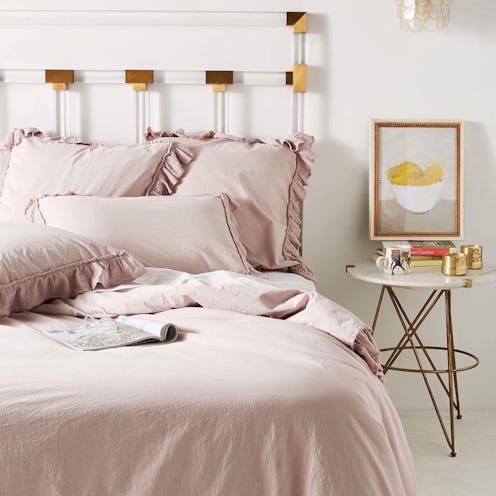Your bedroom is your personal space where you show off your personality and keep your most prized possessions (and a little junk, too). It should also be a comfortable place where you can unwind, relax, and, you know, snooze. They say that an uncluttered room makes for an uncluttered mind, but that state of clarity is nearly impossible to achieve if the area is small, and, most importantly, feels it.
Apartments in bustling metropolitan areas are notorious for having closet-like quarters, and old houses can have rooms that are especially narrow. So whether it’s a guest a room, a kid’s room, or your own sleeping nook, how do you turn your bedroom into a sanctuary without making it look cramped?
Luckily, square footage has nothing to do with making a space stylish, and there are some tricks of the trade that can make tight areas feel more open. Read on for expert advice from interior designers on how to transform a tiny room into a functional and airy oasis.
1. Paint The Ceiling A Dark Color
Giving your walls some fresh color? Consider painting the ceiling, too — and stick to a dark hue. “People never believe me until they try it,” says Lori Dennis, owner of Lori Dennis, Inc. in Los Angeles and star of HGTV’s The Real Designing Women. “The dark color recedes and makes the ceiling feel farther away.”
2. Repeat Colors & Patterns
If you love a certain color or pattern, use it everywhere to create the illusion of endless boundaries in your bedroom. “Use the same pattern for wallpaper, drapes, and even upholstered furniture like a headboard or chairs,” explains Dennis. “It makes the edges of the room somewhat disappear and feel more spacious.”
Sarah A. Abdallah, interior architect and owner of Bespoken Design Firm, Functional Creative Design (with headquarters in New York City), adds that color can have the same effect. “Coordinating colors is an important feature of any room design," she says. "Go monochromatic: Same or similar paint colors throughout the space creates seamless fluidity, making it feel larger in aspect.”
3. Choose Colors According To Natural Lighting
When picking a color for your room, Abdallah says that it’s imperative to consider natural lighting. If your space has lots of it (for instance, if there are south or west-facing windows), don’t be afraid to go for a bold color. However, rooms with less access to sunlight may benefit from lighter walls.
“Paint is hands down the easiest, most inexpensive thing you can do to transform the look of your space and the right color choice can actually help your small space appear larger,” explains Nicole Gibbons who founded Clare, a company who has redesigned the paint-buying experience. “Bright, airy colors will reflect more natural light and help open up the space, making it feel bigger than it actually is.”
4. Use Strategically Placed Mirrors & Drapery
You may have already heard of the mirror rule, but Dennis emphasizes that placement is key for the best illusion. “Don’t go wall to wall, but consider a well-placed, well-portioned, and clean-beveled edge to visually expand the space,” she says.
A lesser-known trick involves being mindful of where drapery is installed. Attach rods where the wall meets the ceiling instead of at the top of the window, and the room will appear taller.
5. Be Mindful Of Your Furniture
Make sure you choose furniture that is proportionate to the room so it doesn’t look too crowded, and don’t forget to consider height. “Additionally, when keeping furniture lower to the floor, the ceilings feel higher, allowing your bedroom to look and feel much bigger than it is,” Abdallah says. She adds that multi-use pieces, like headboards that double as book shelves or side tables with storage, help preserve precious space.
And while it may seem counterintuitive, Ariel Kaye, founder of Parachute, suggests adding interest with lots of perfectly sized pieces, as opposed to just a few. “The eye likes to travel, but in a small bedroom it doesn’t have far to go!” she points out. “Don’t be afraid of filling the room with furniture. People often assume that if a room is small, it needs to be sparse. Furniture can actually make a space feel larger.”
